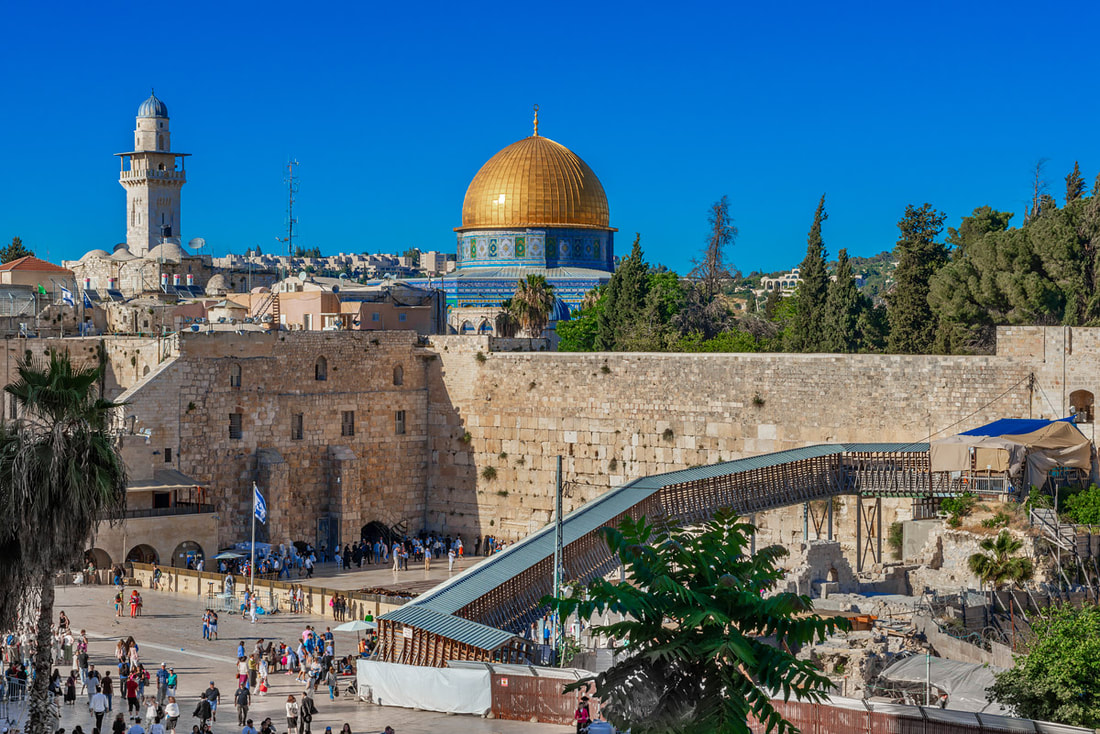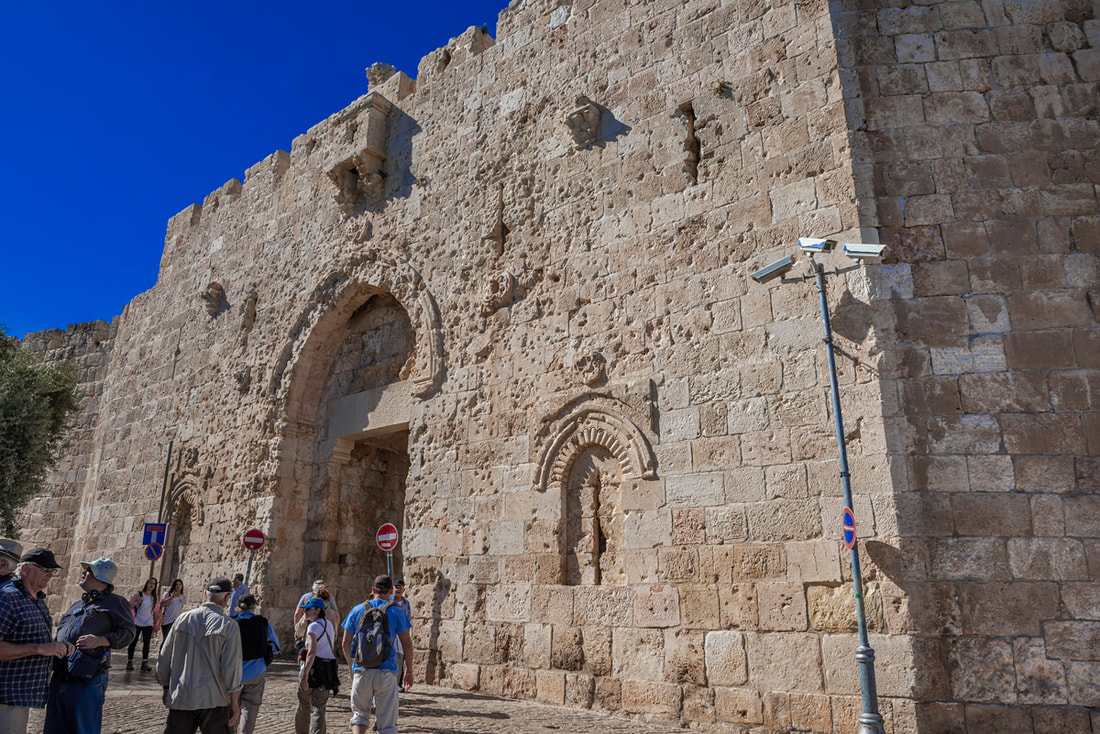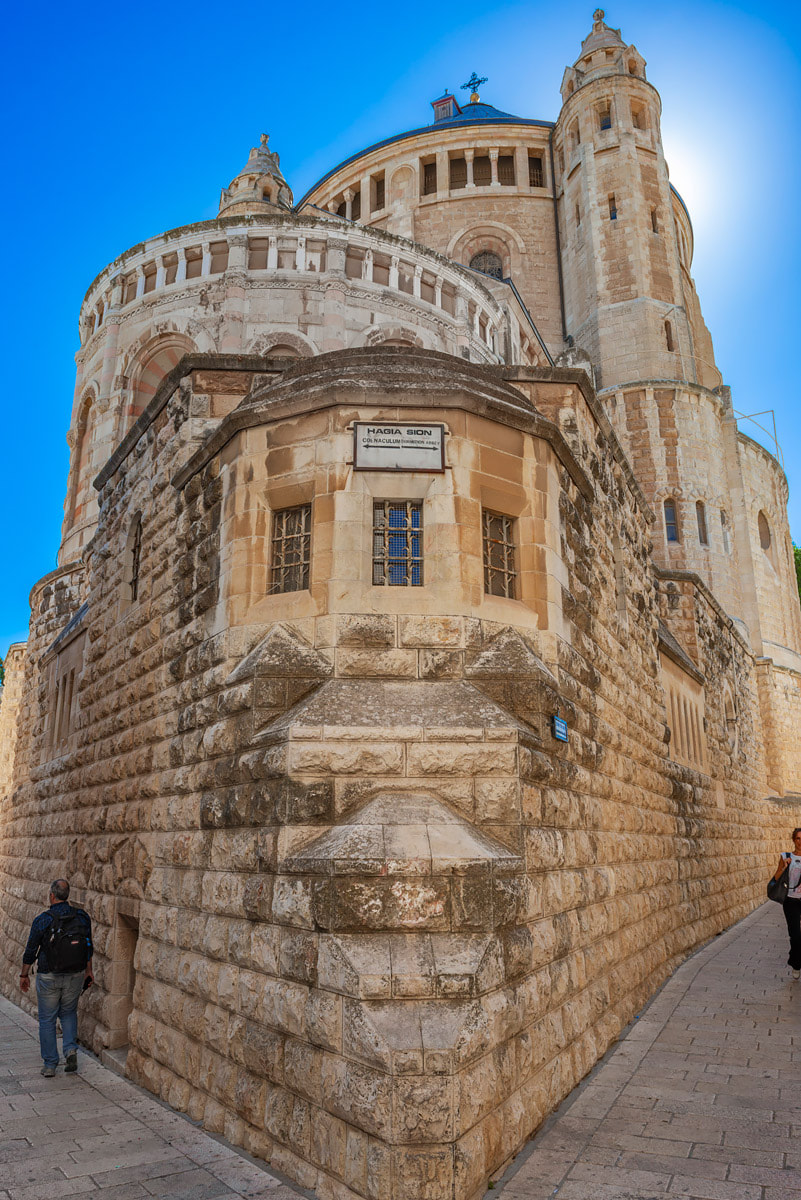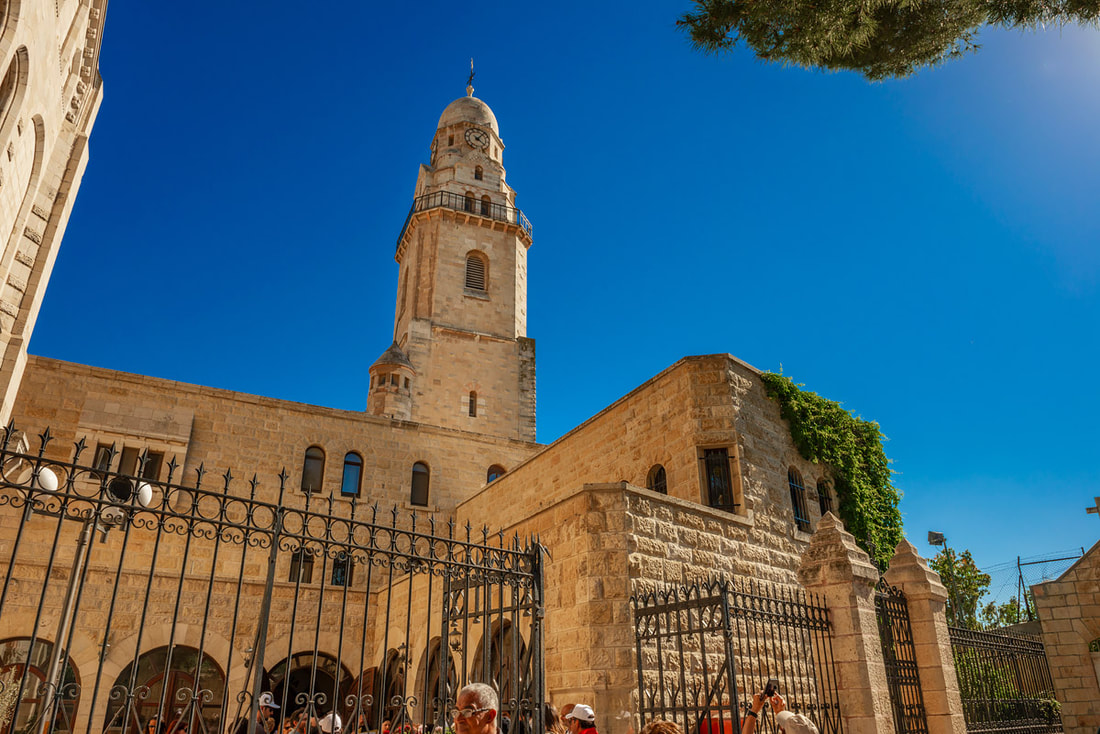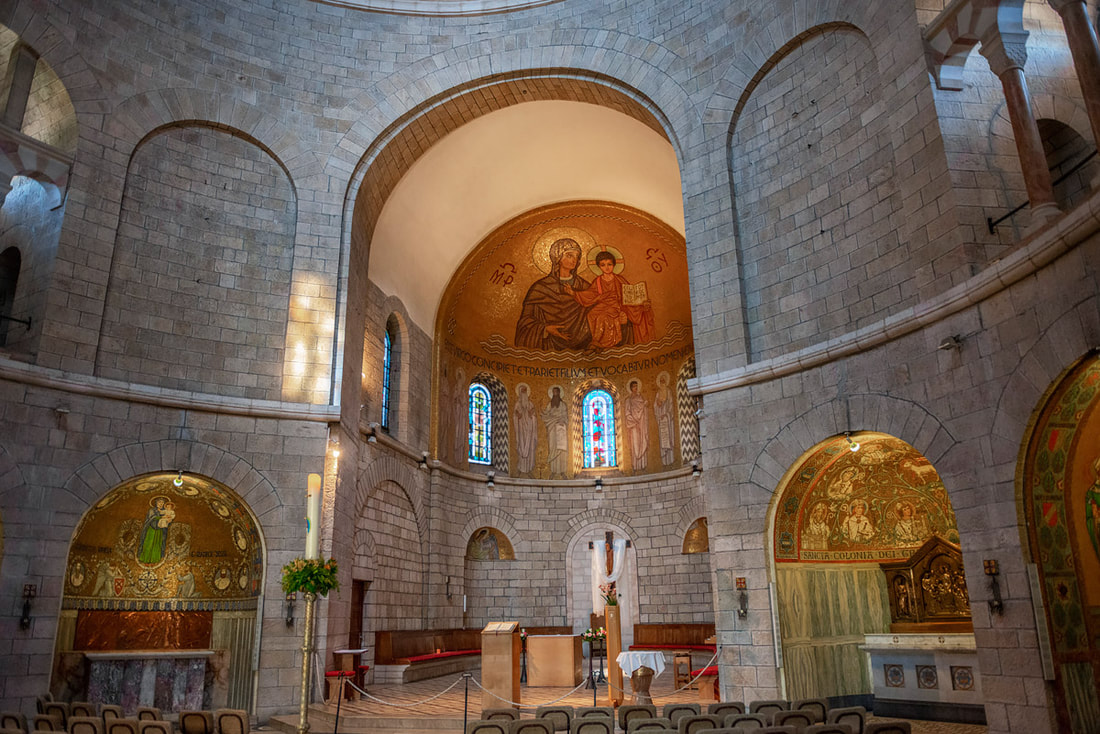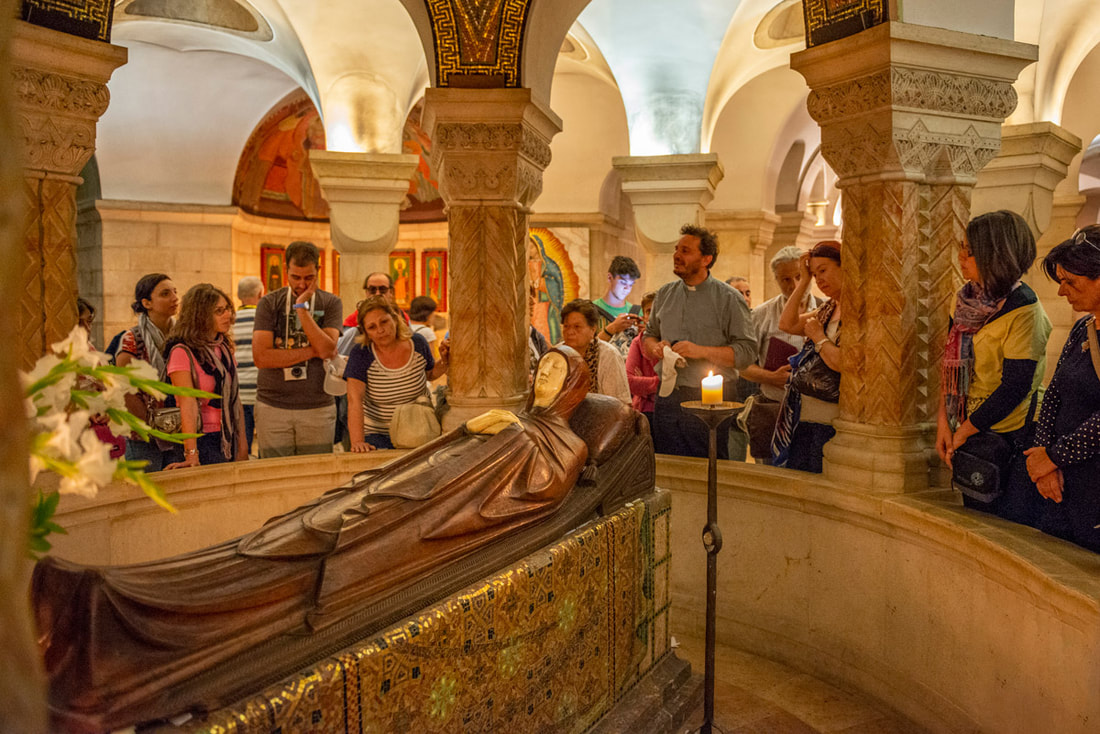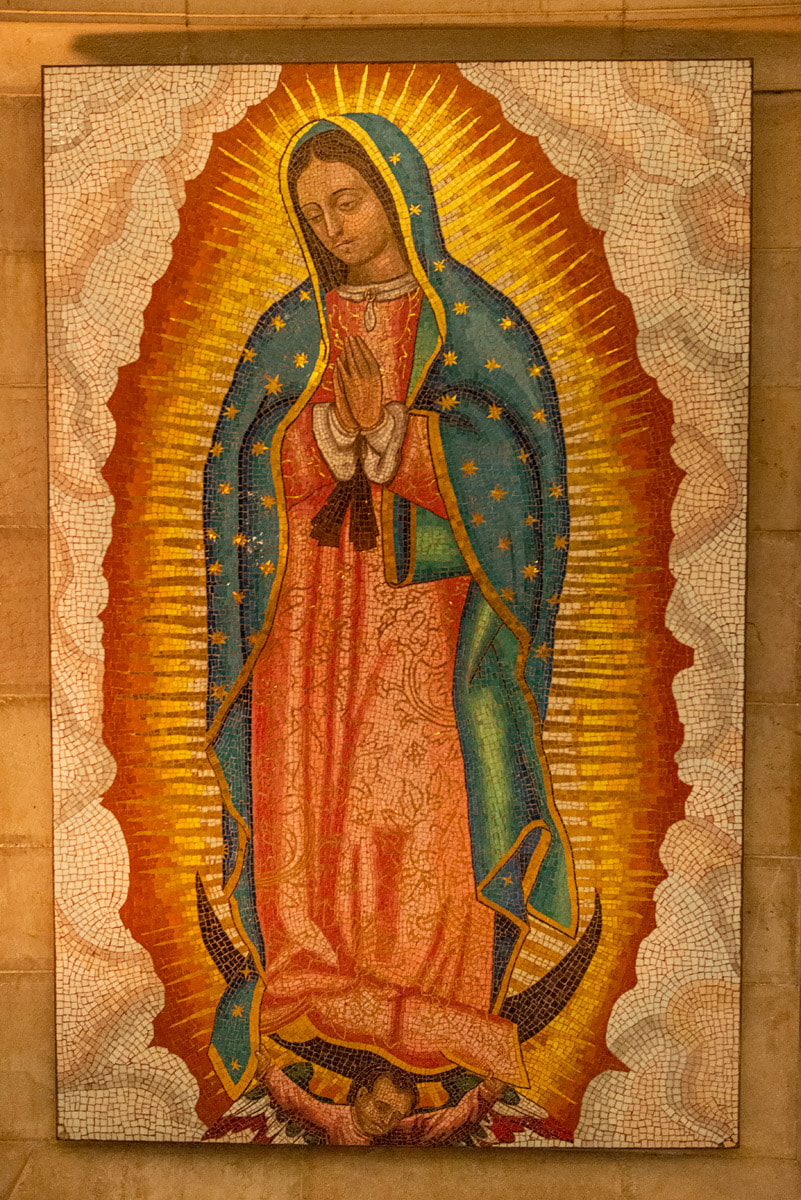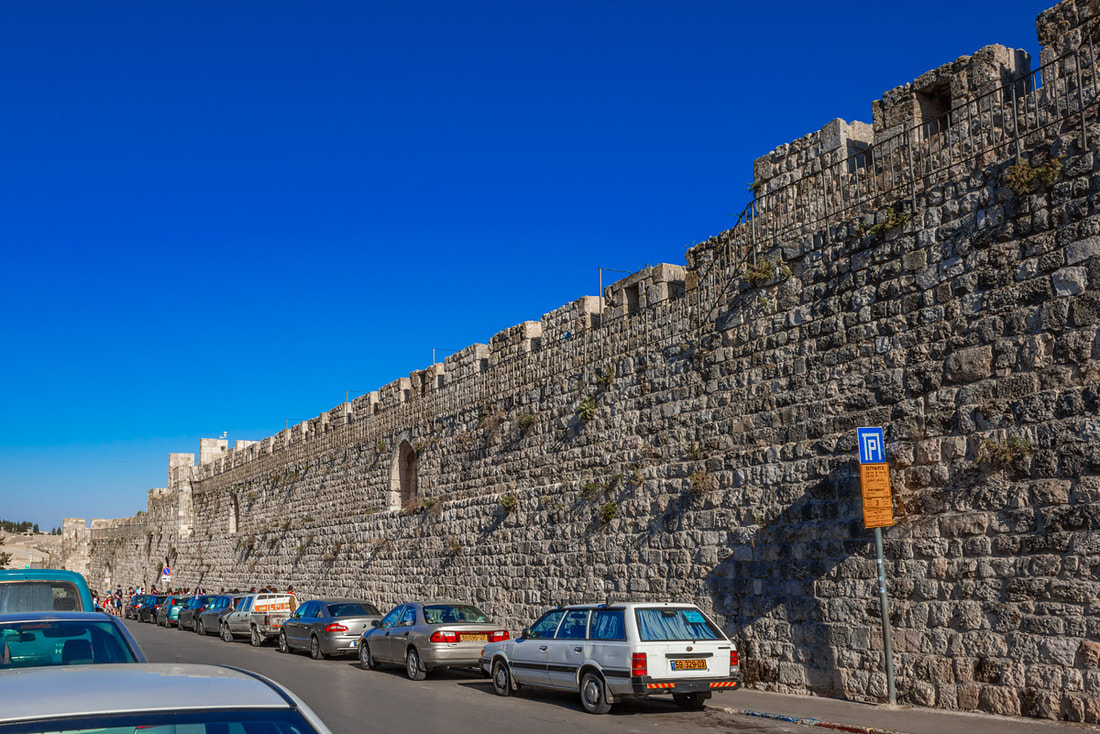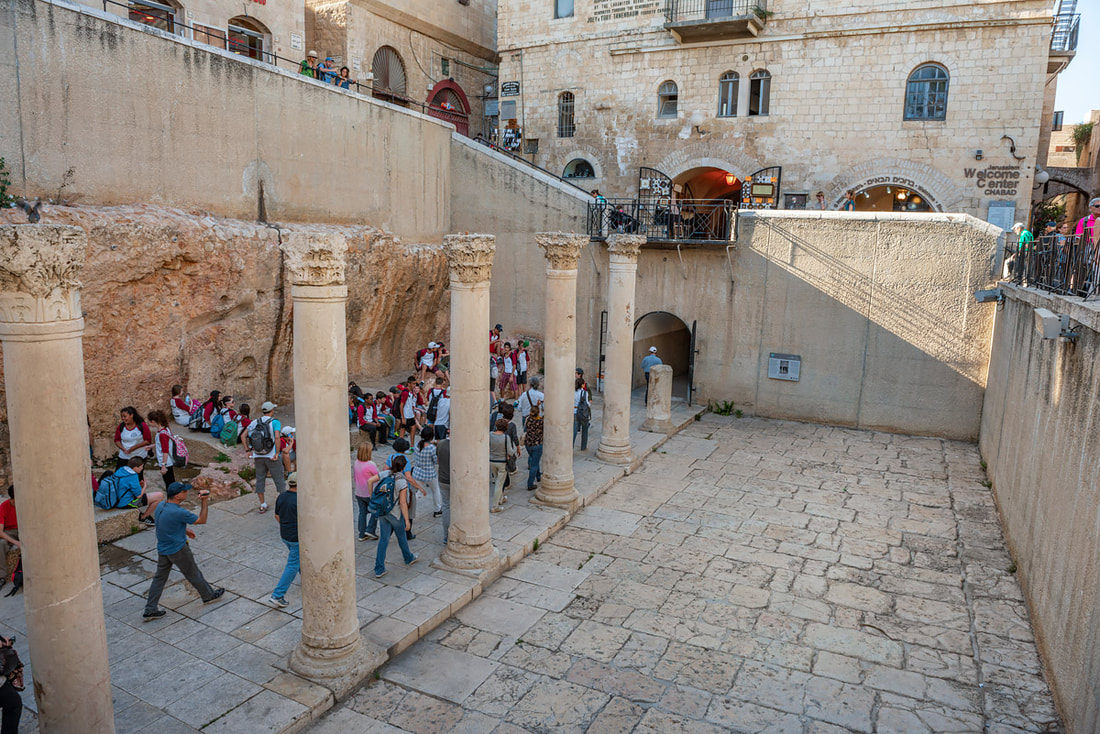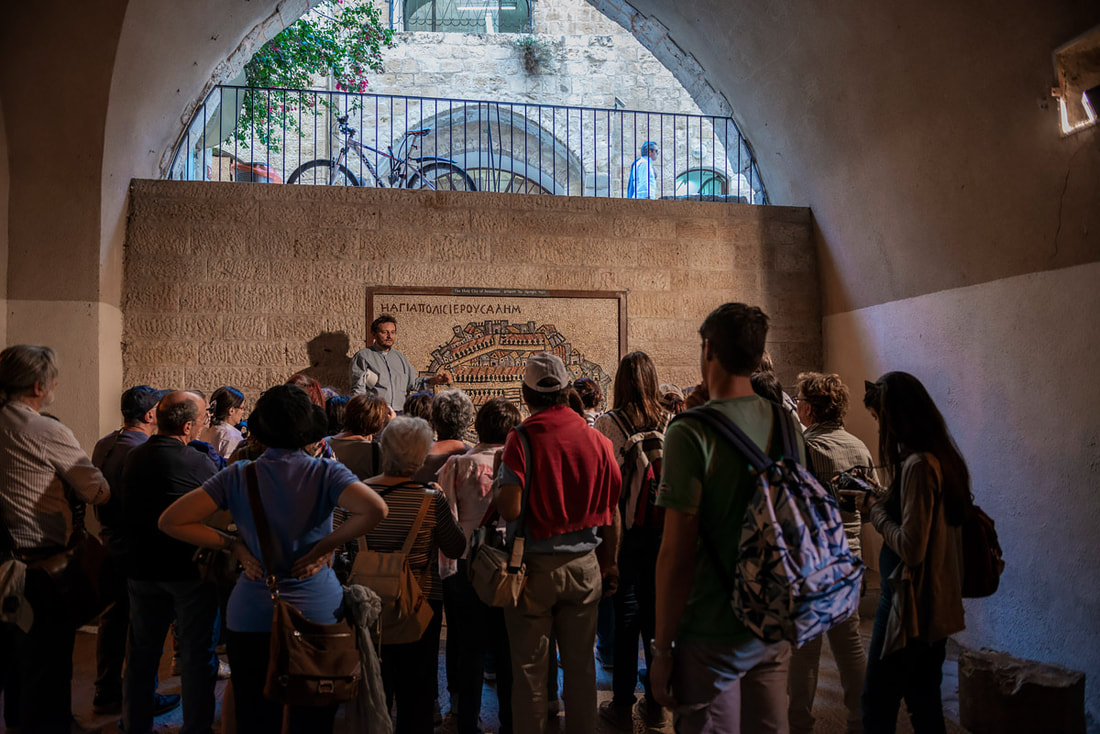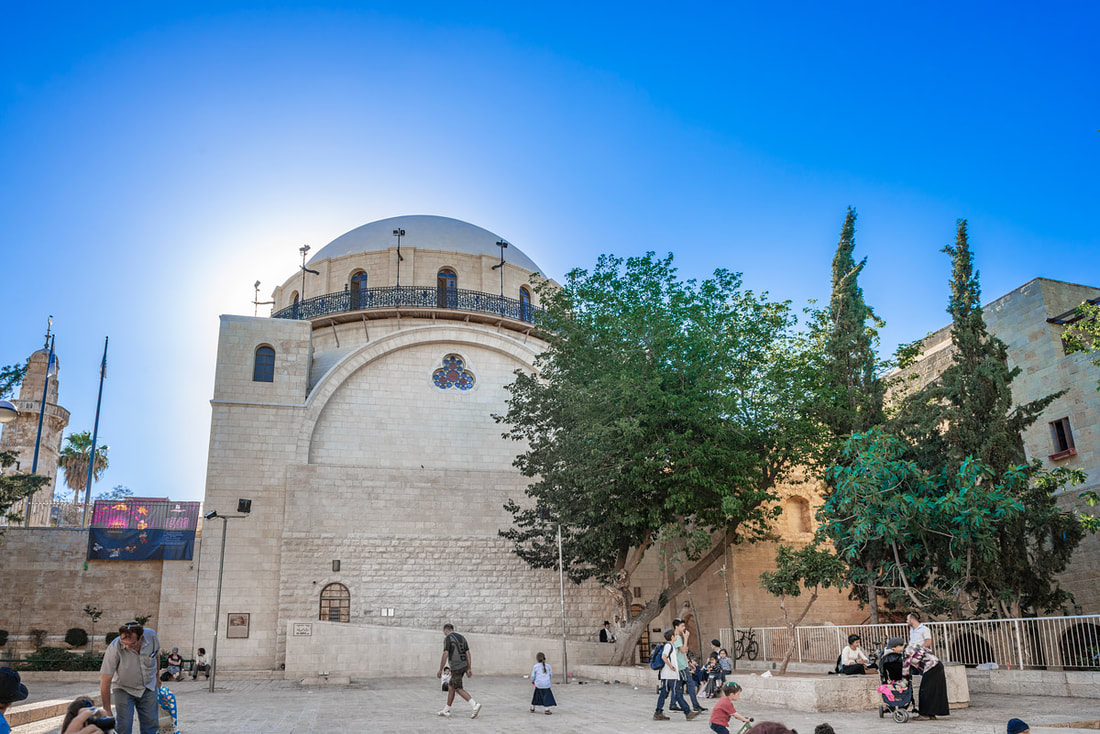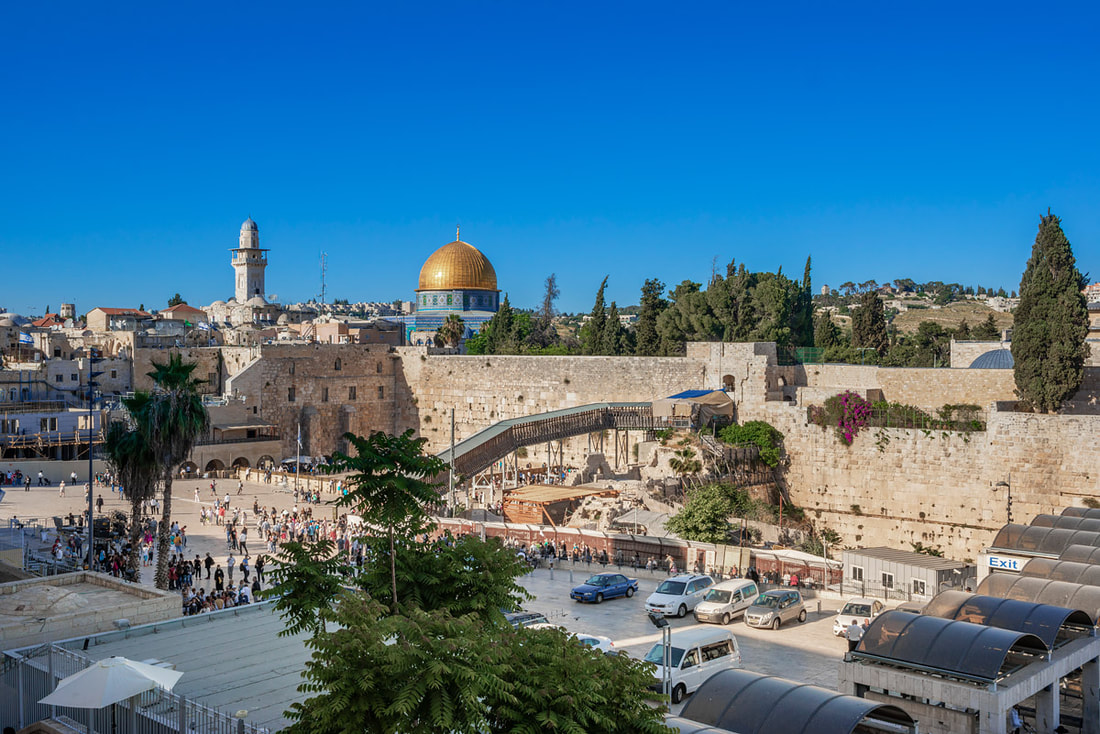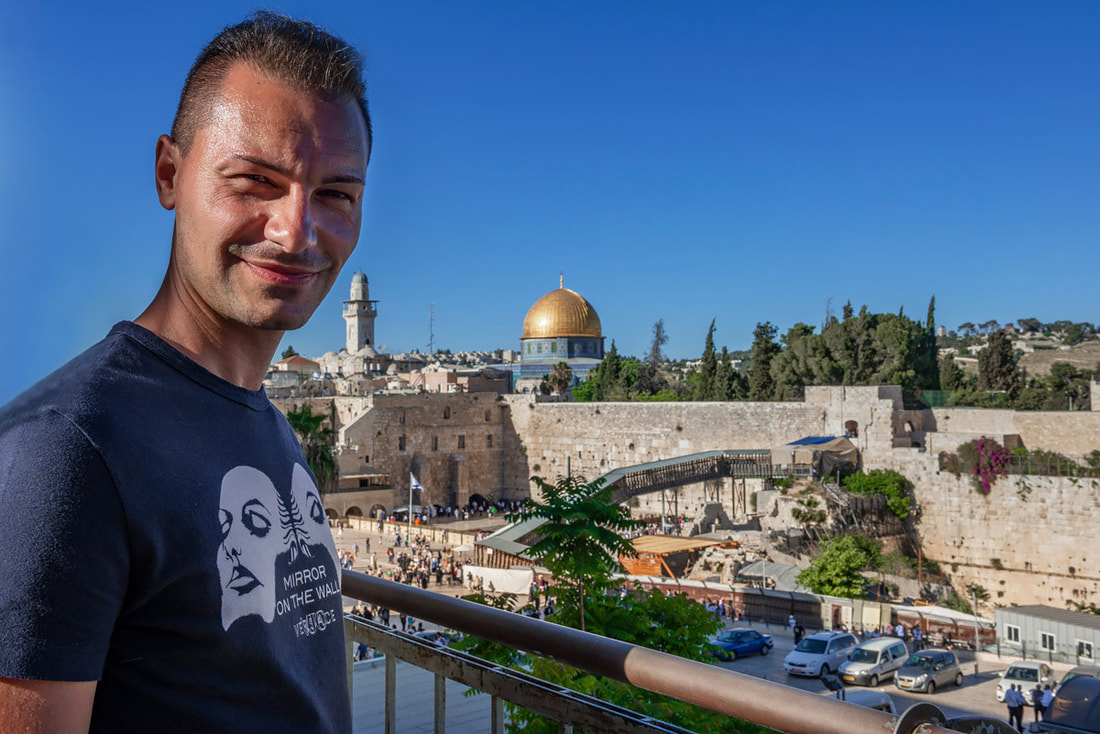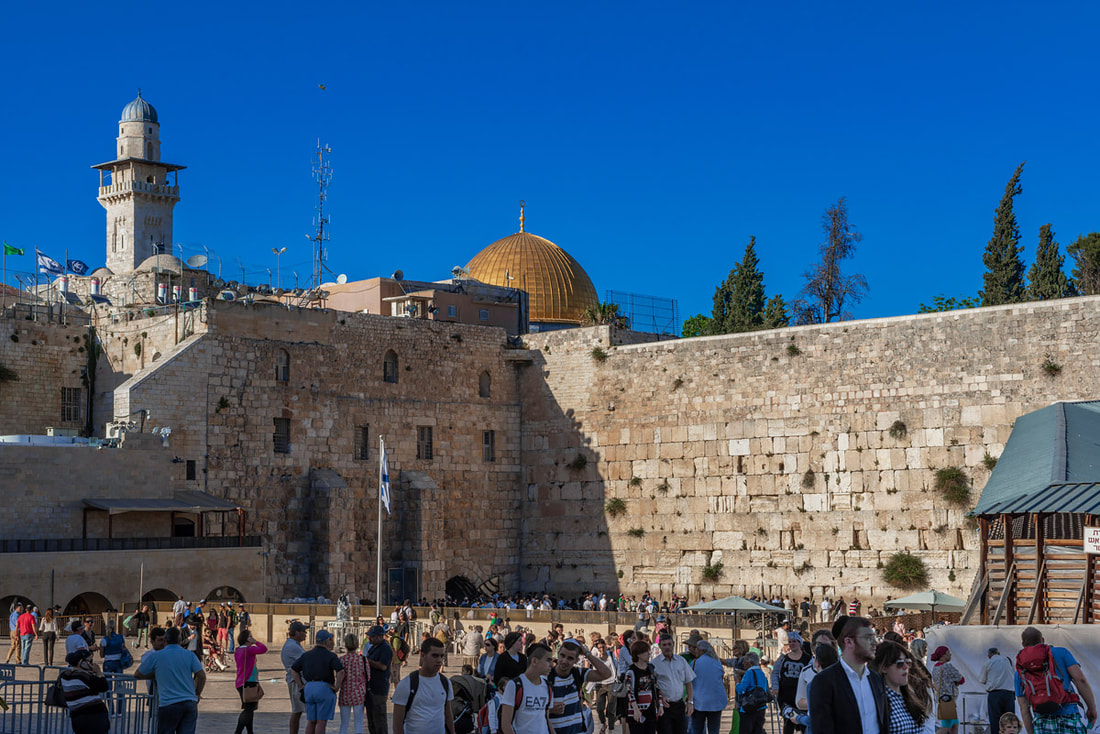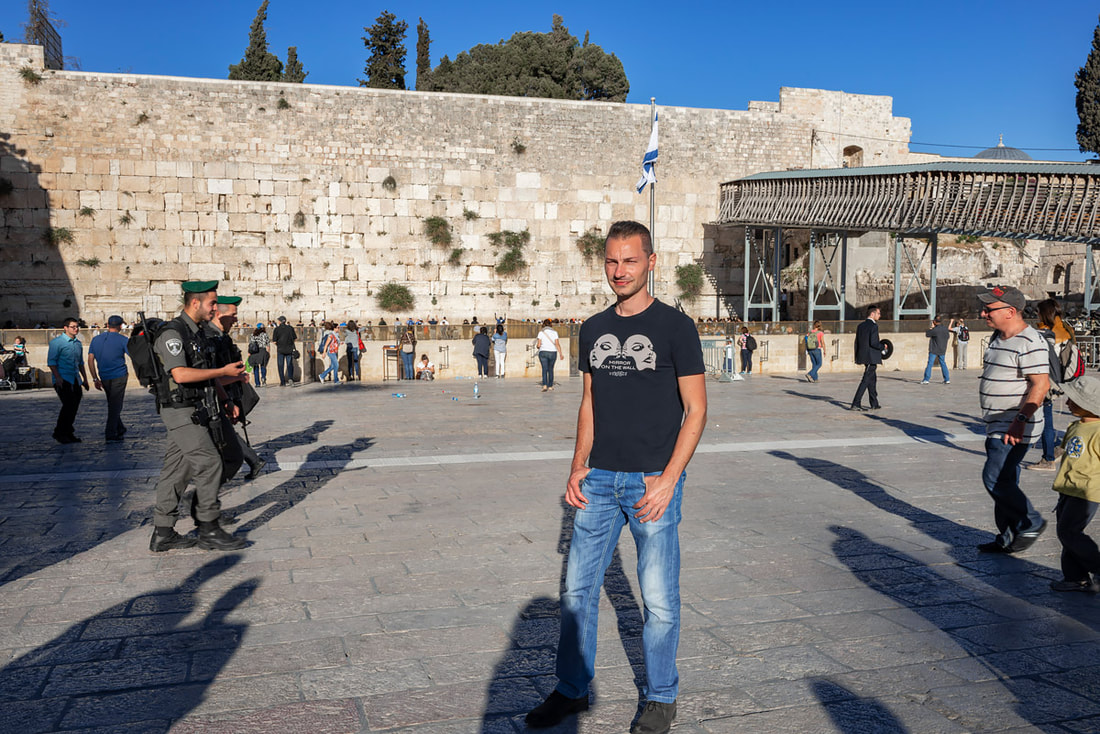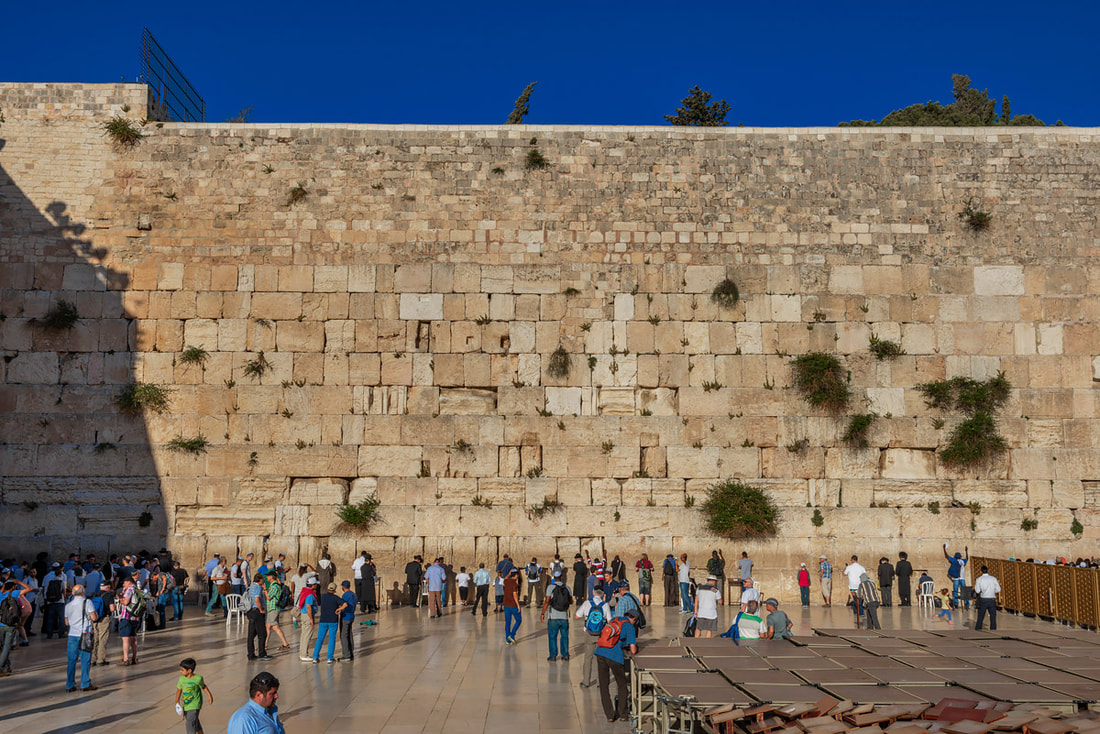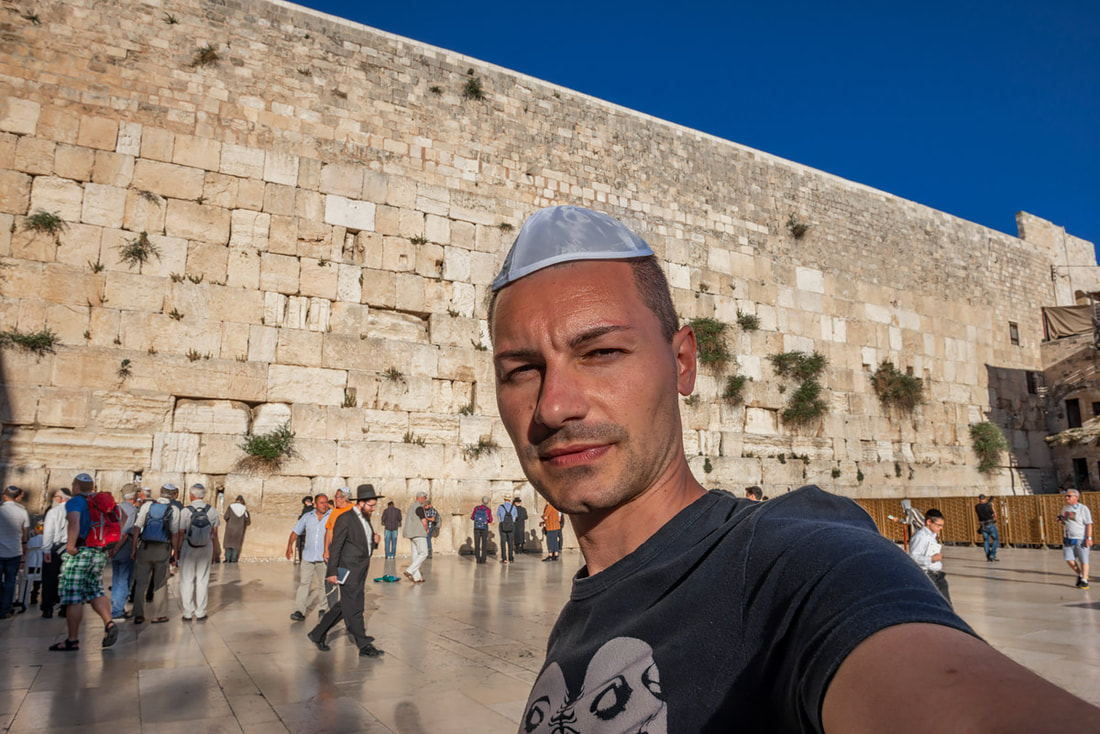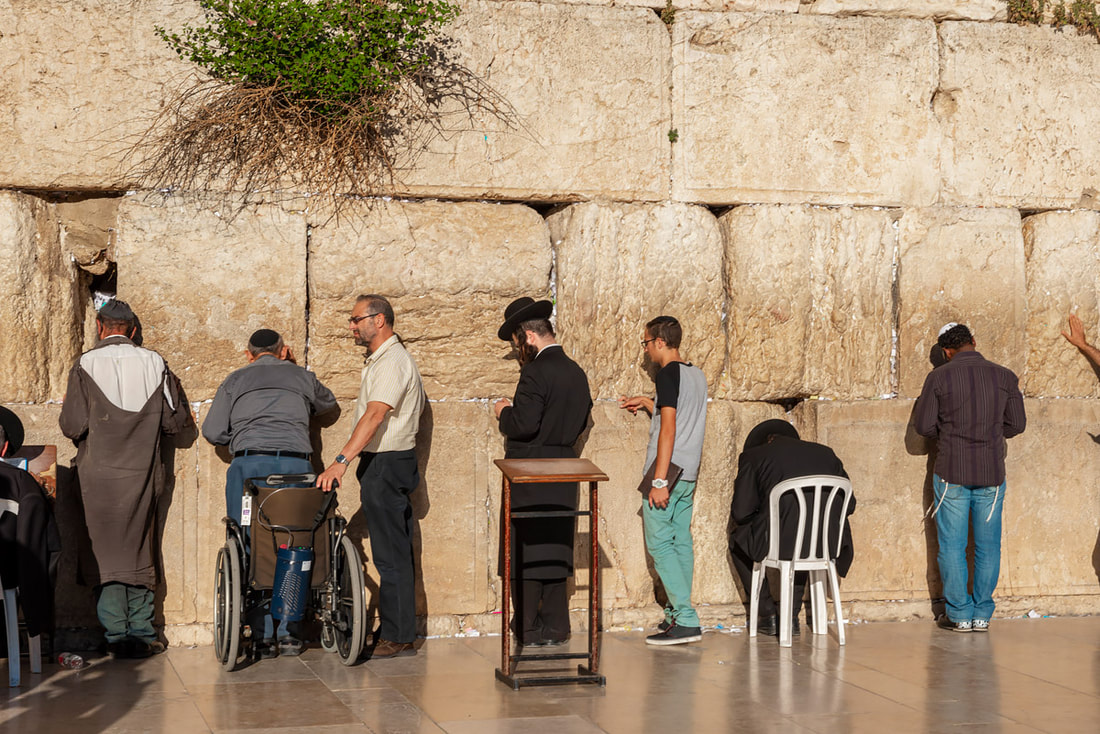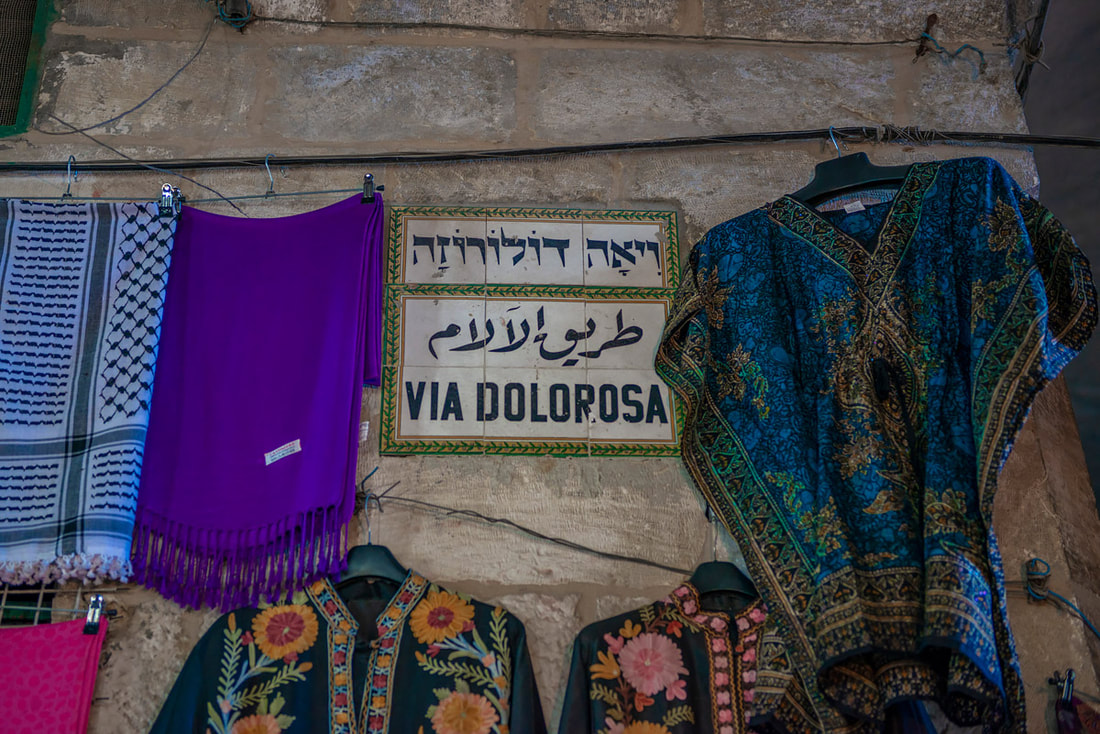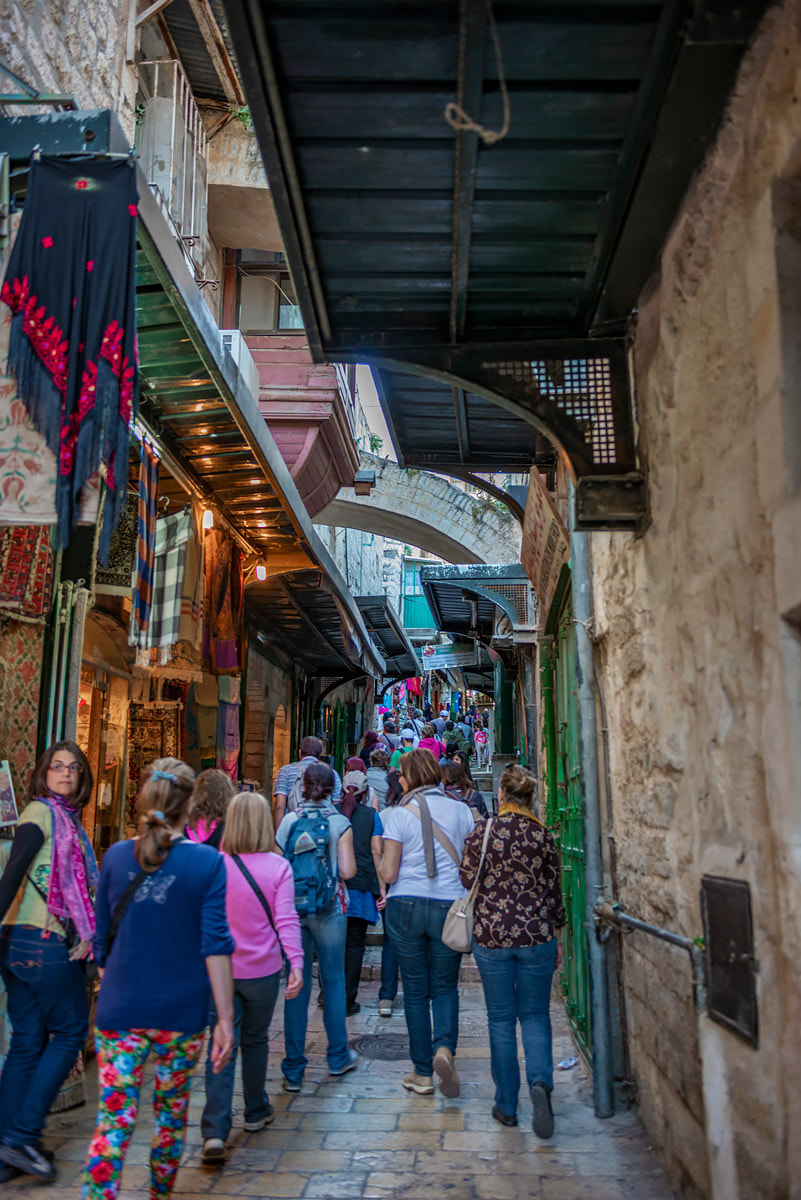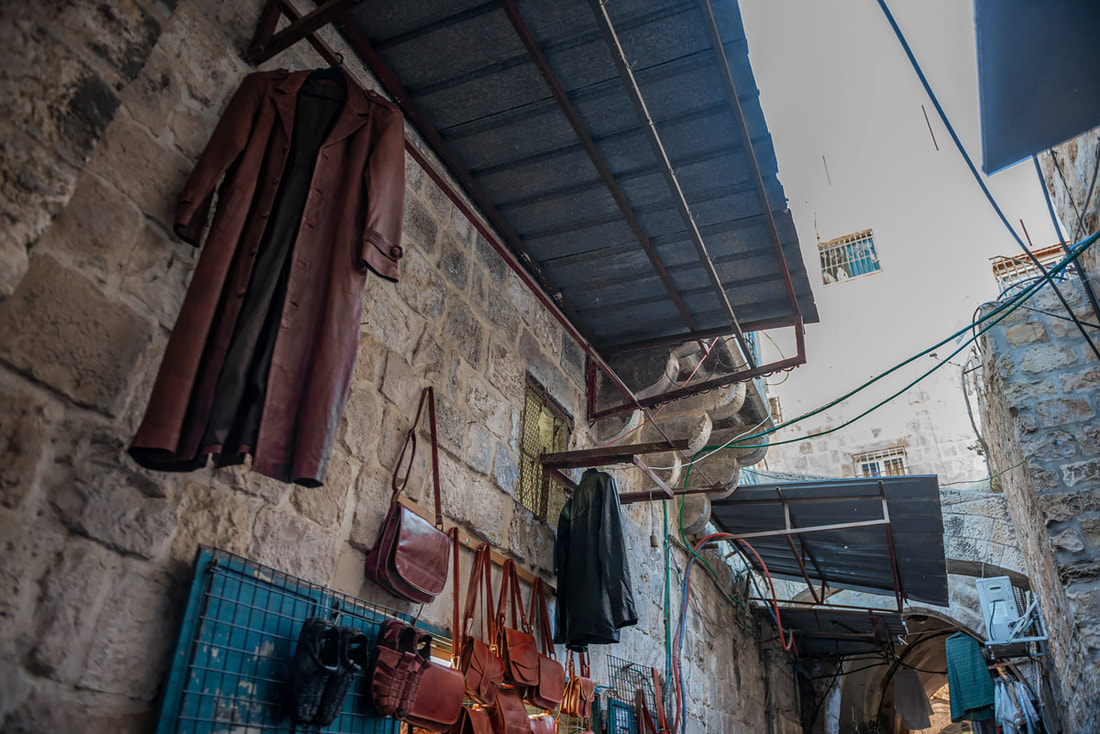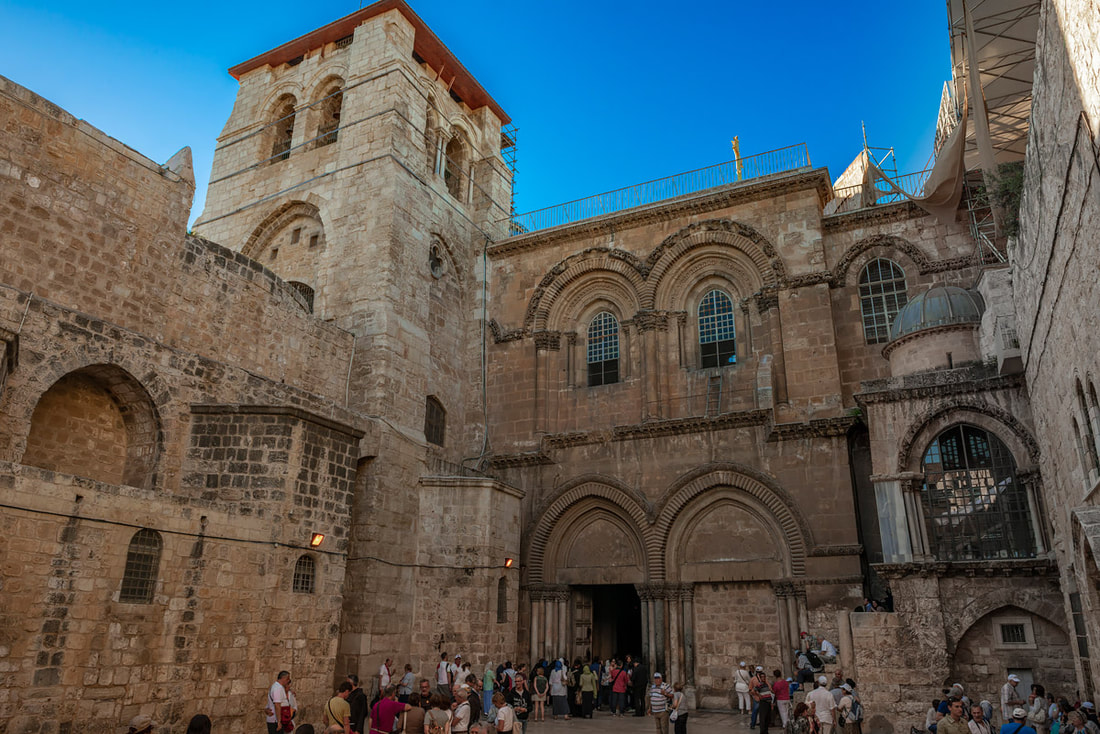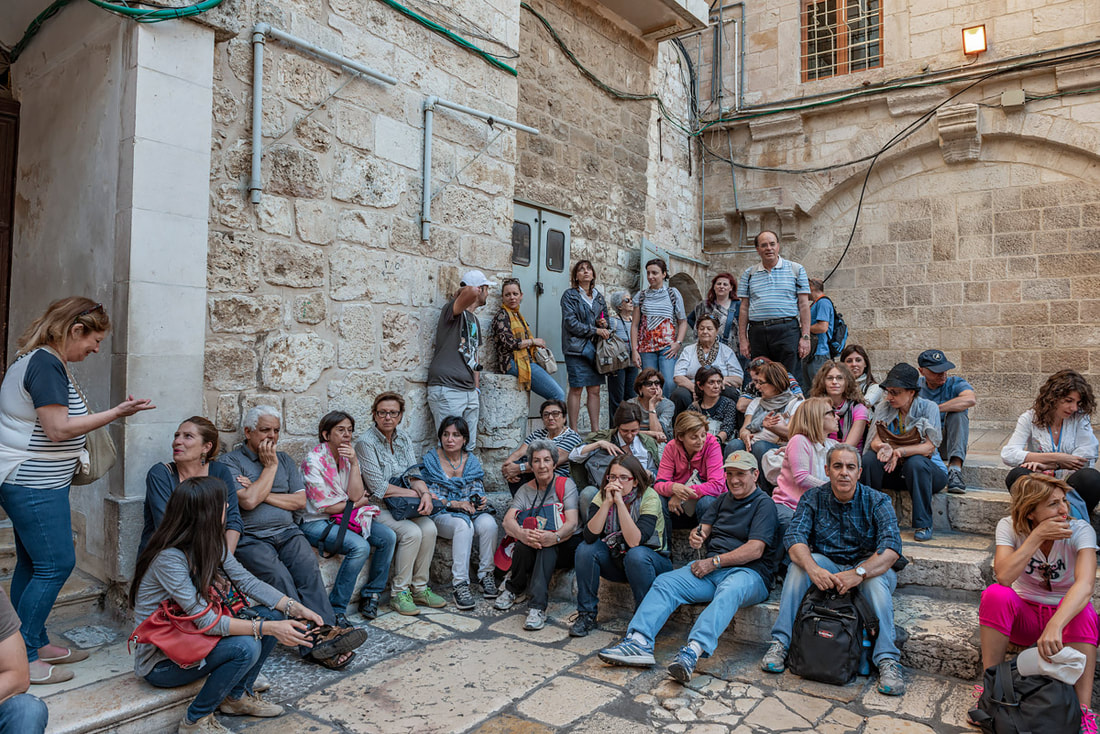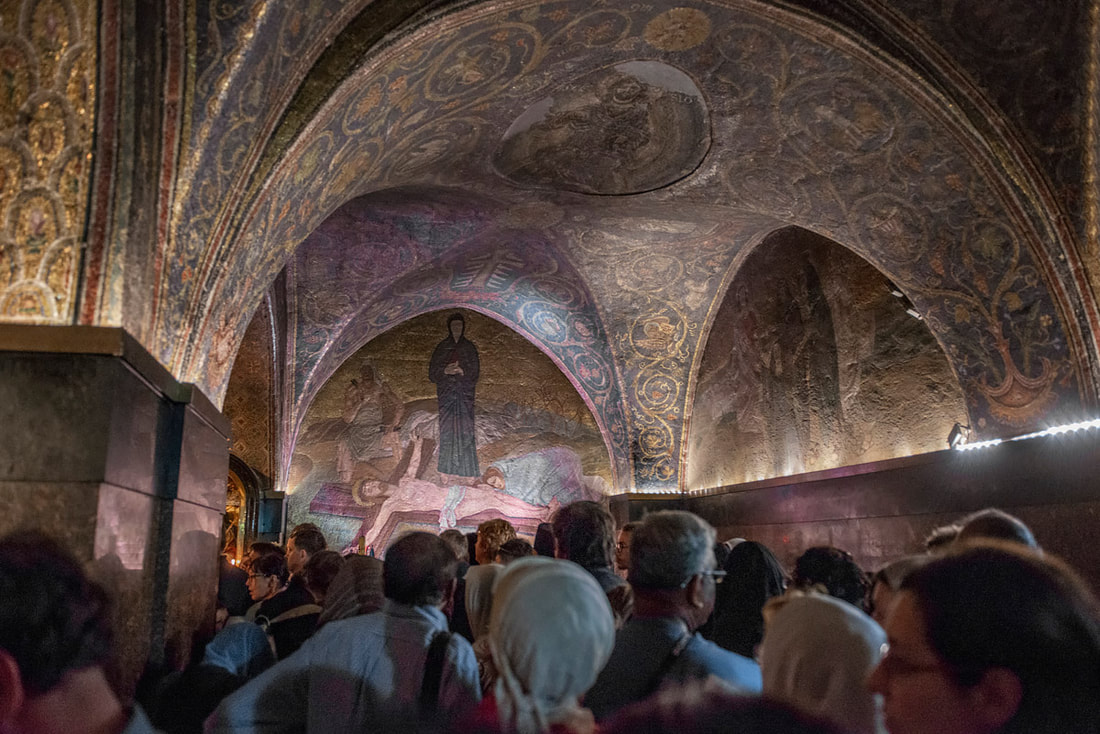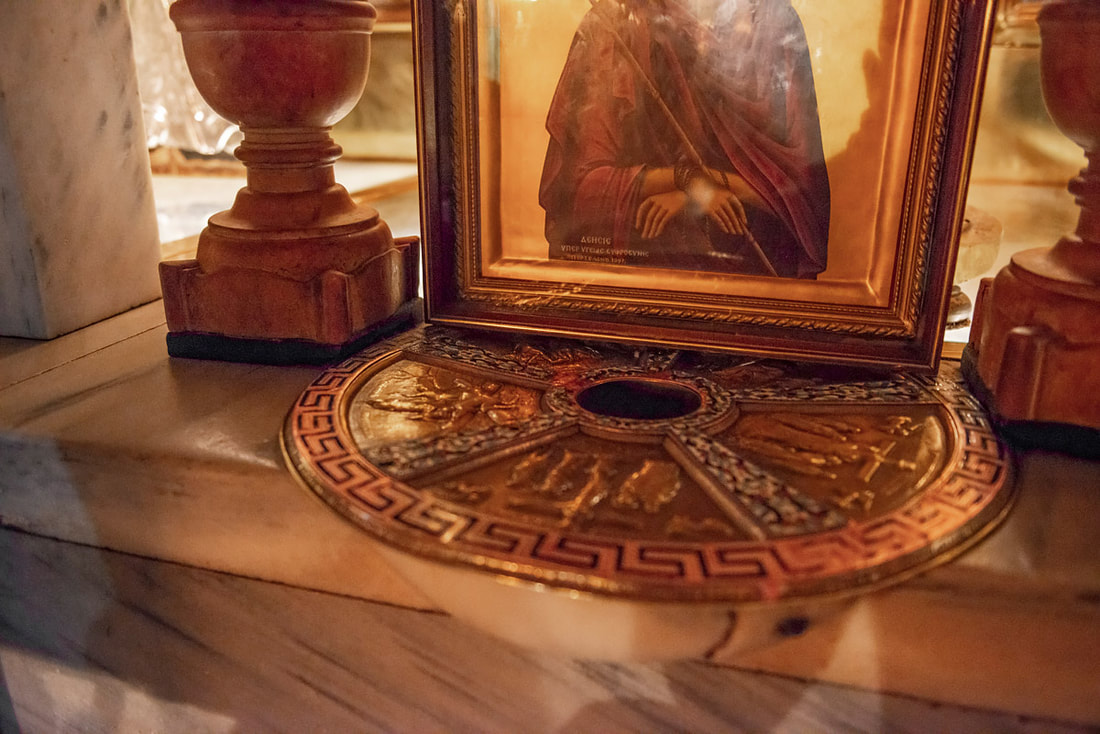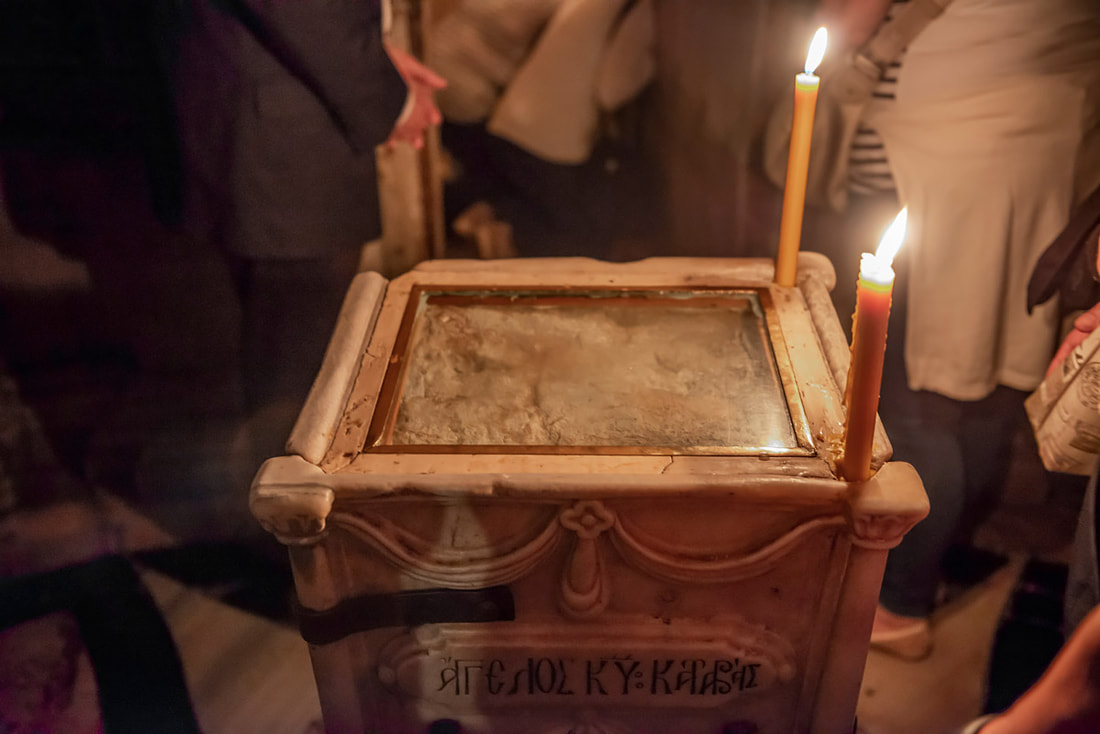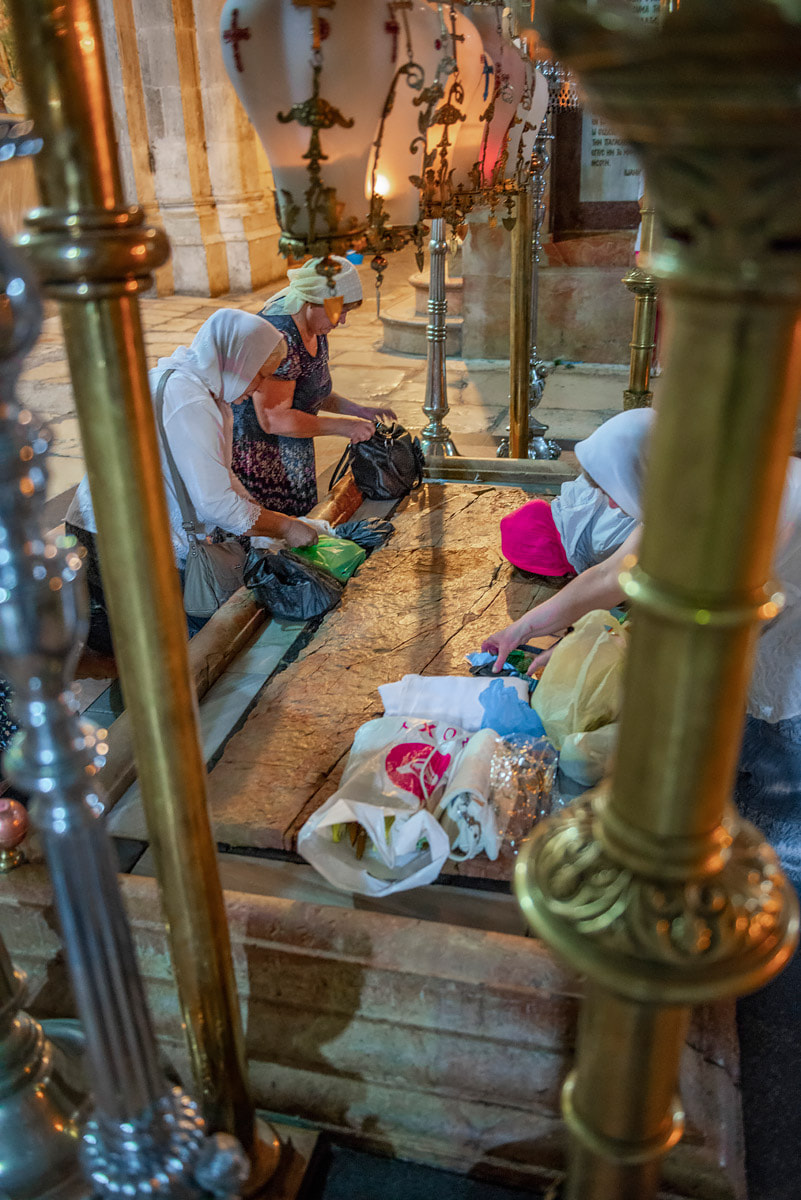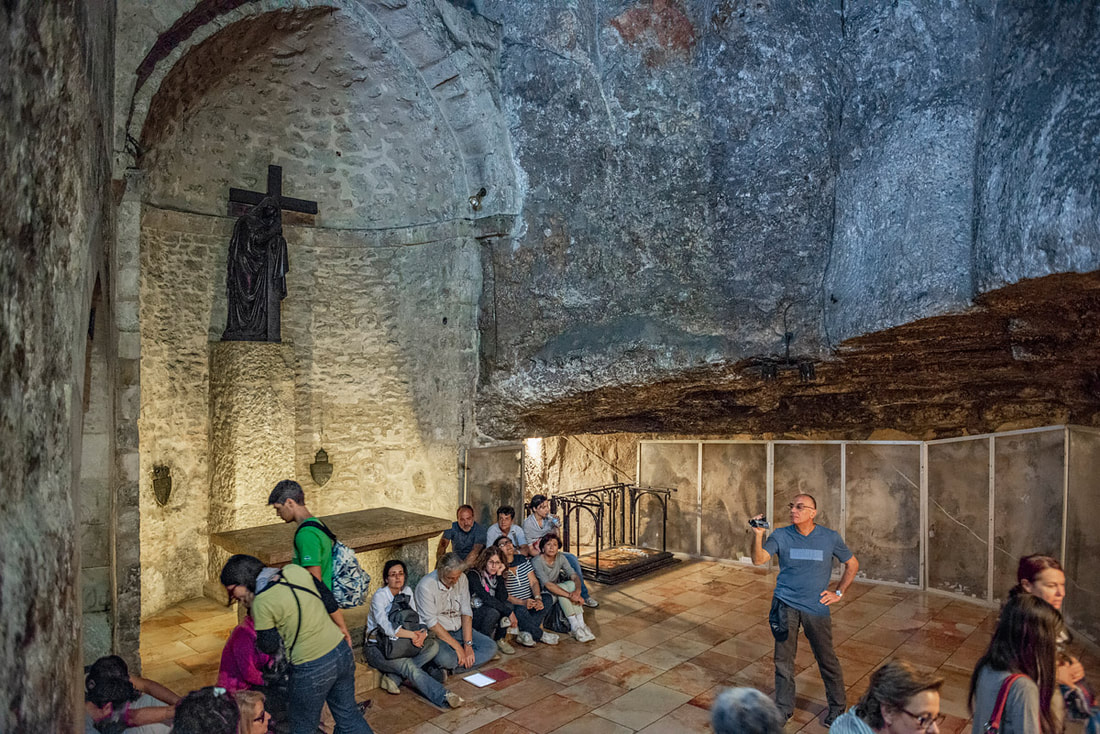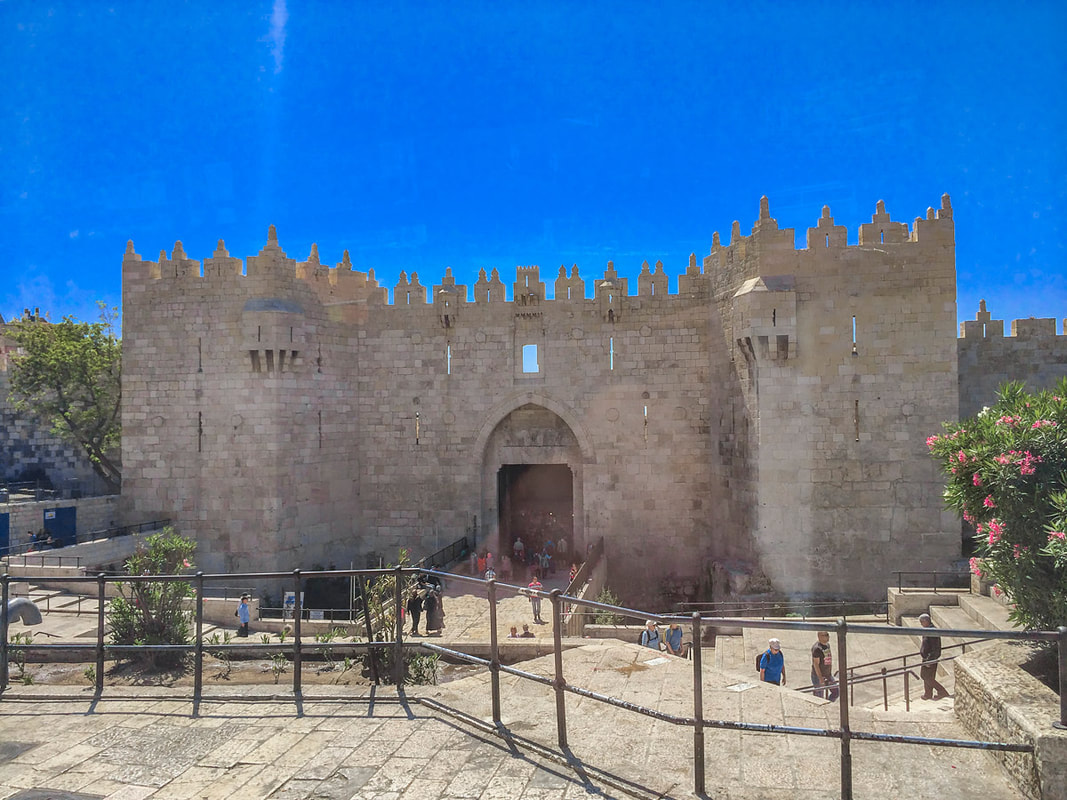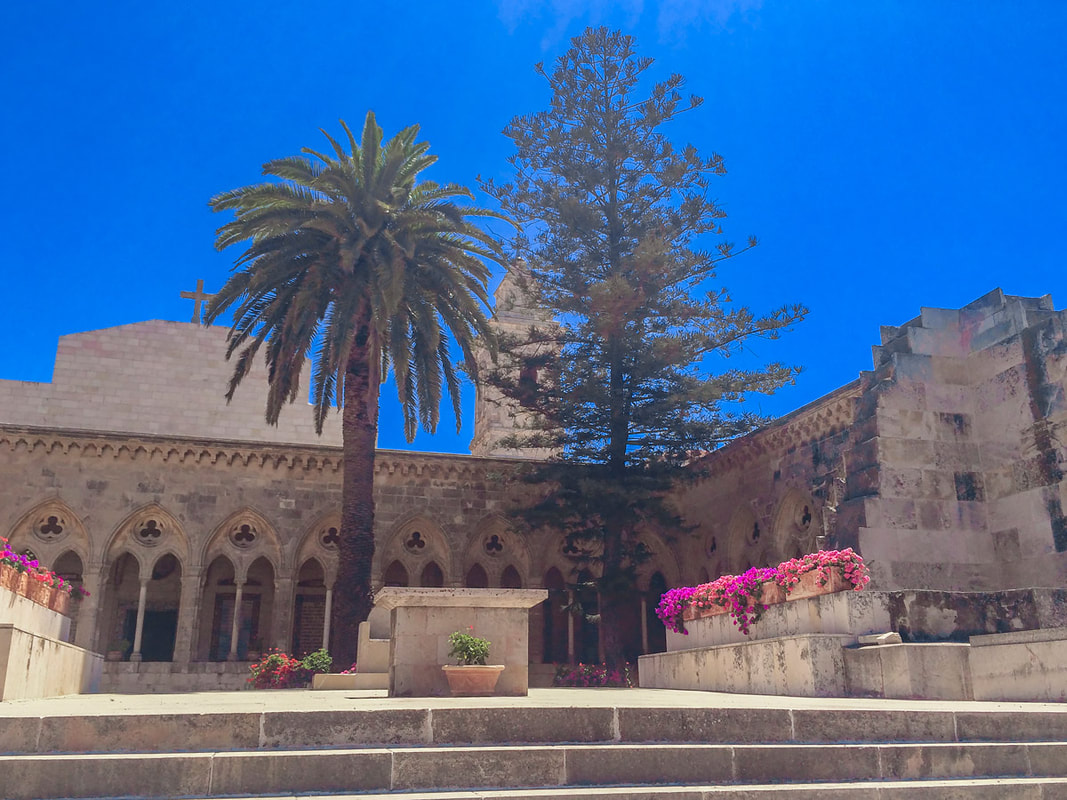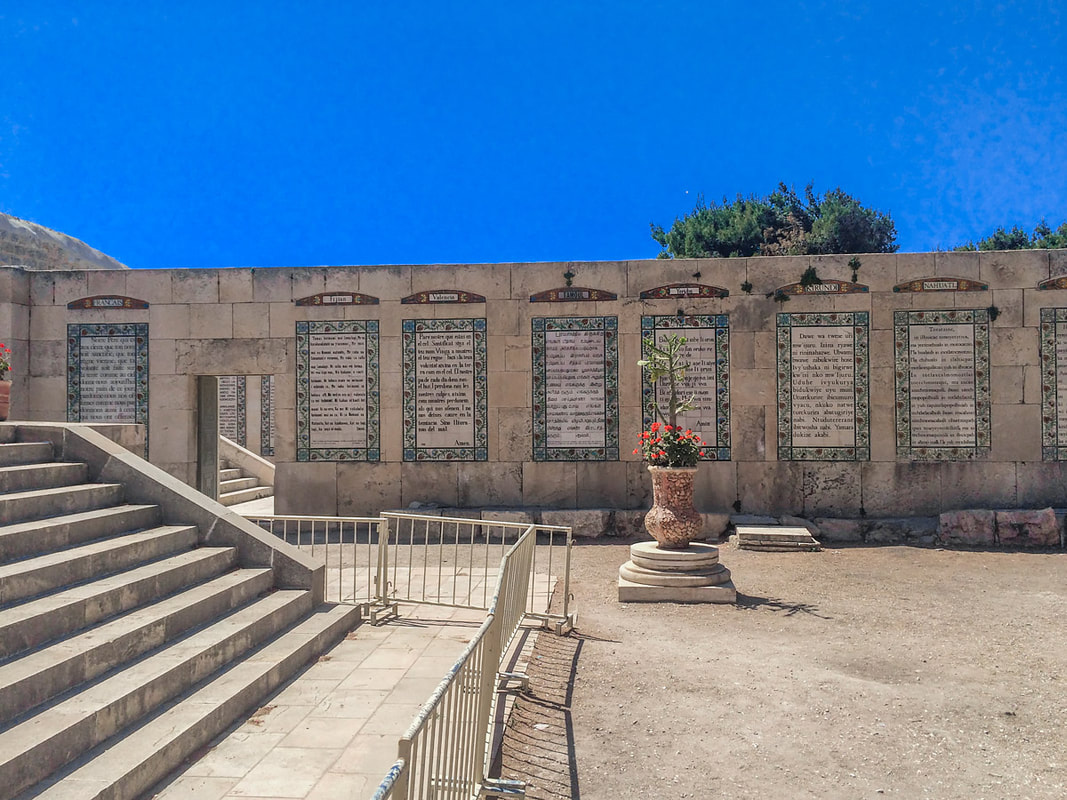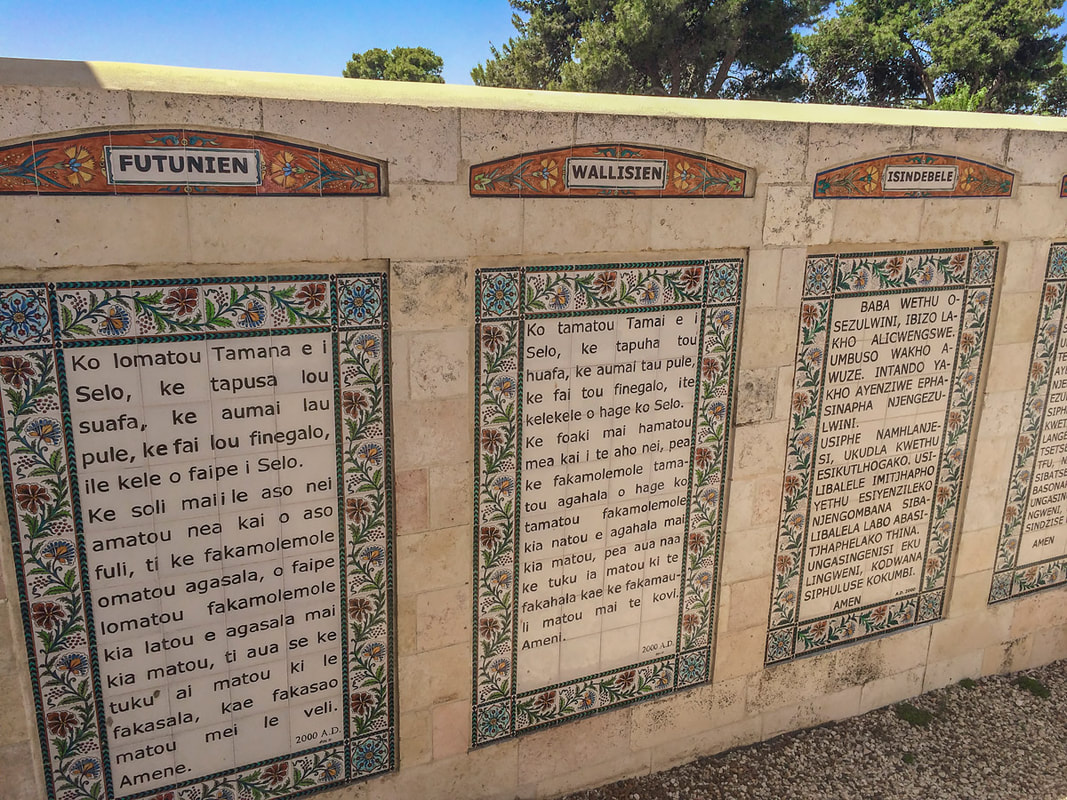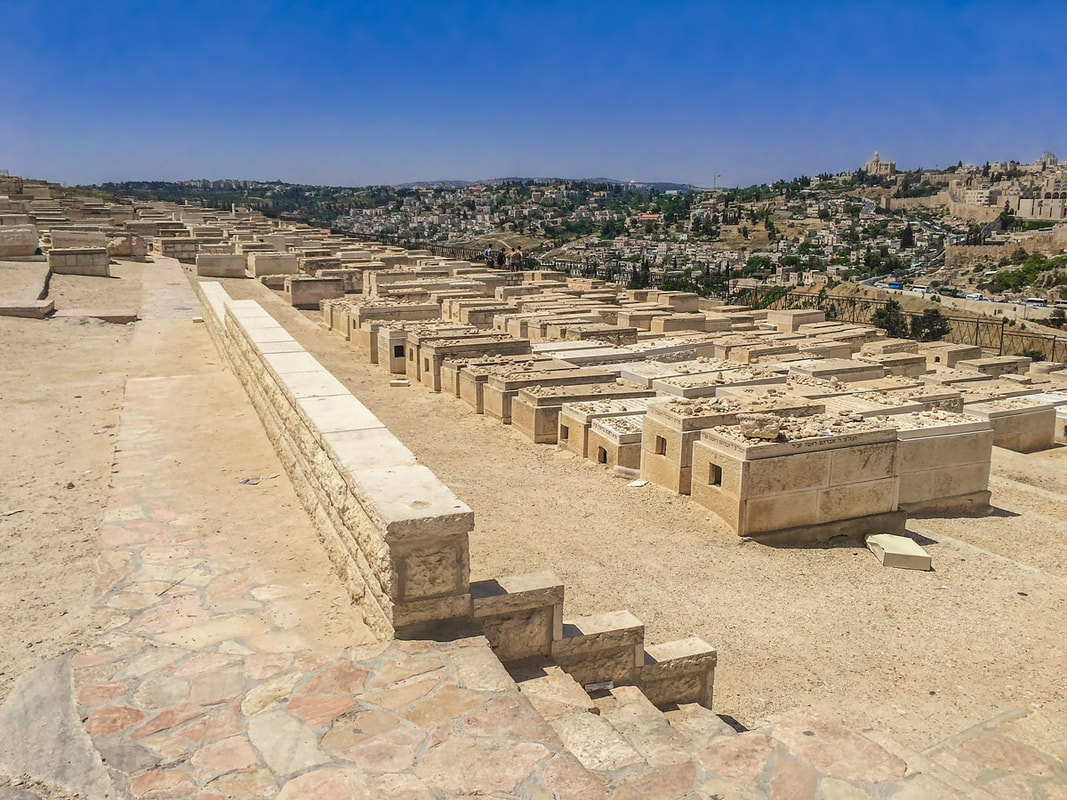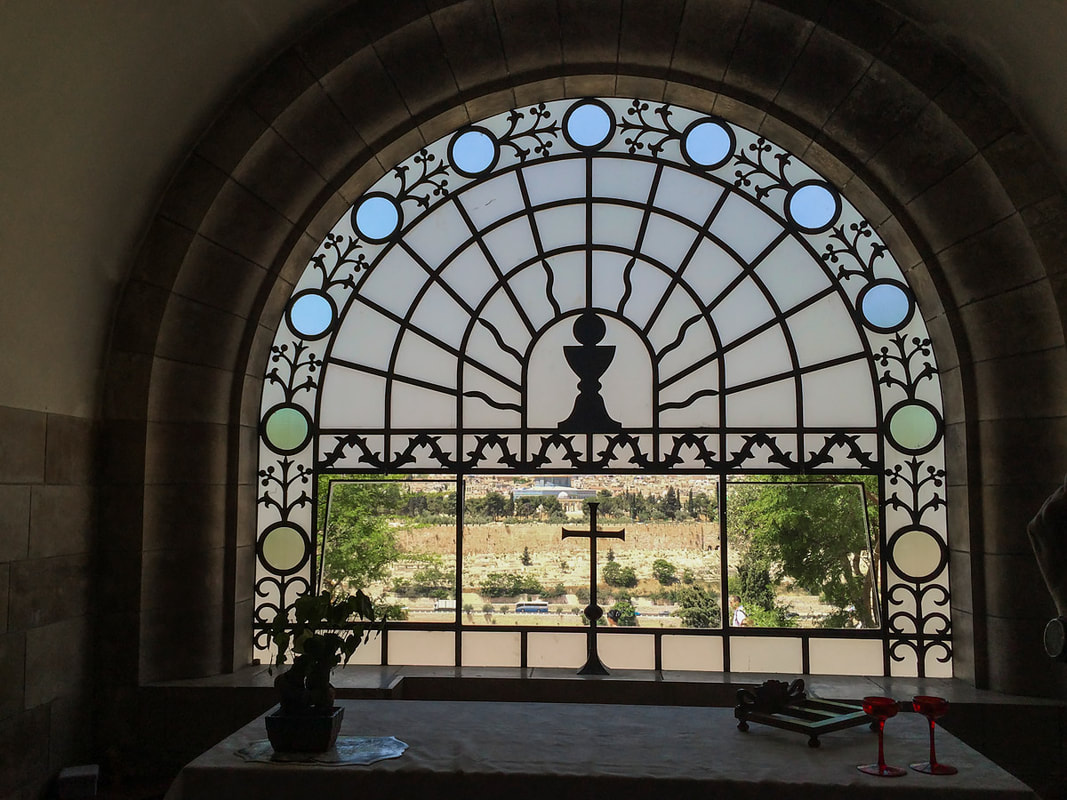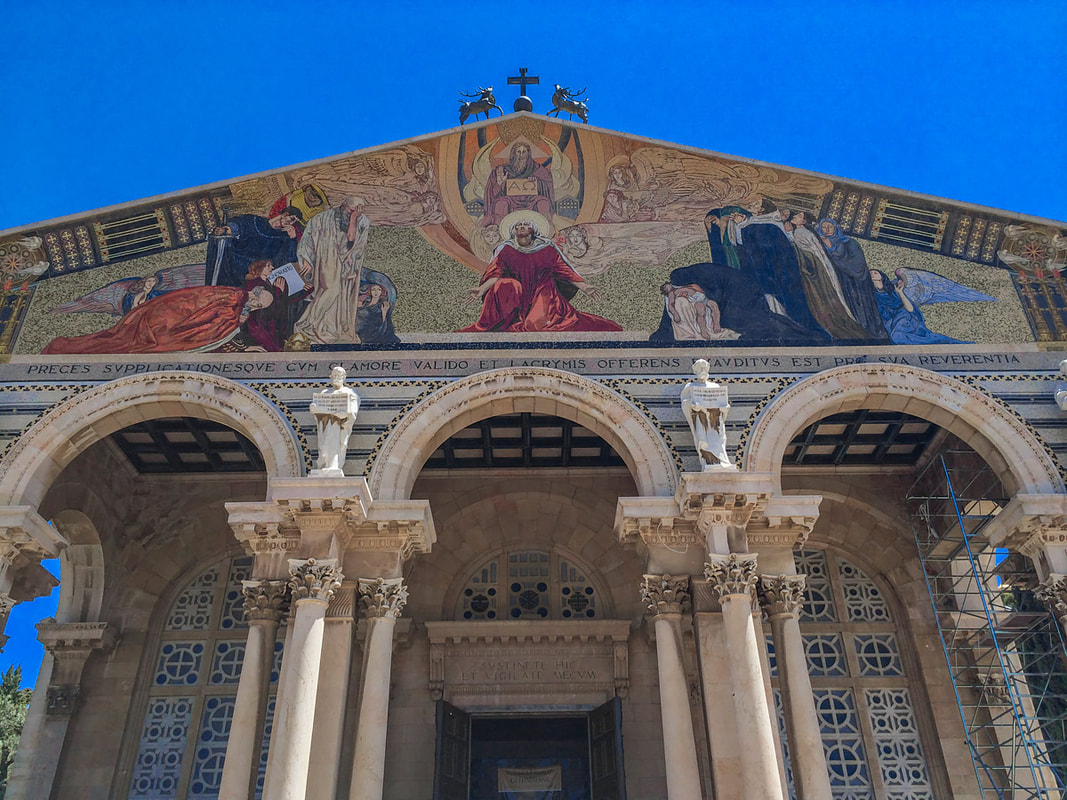By Antonio MalaraDay 1Jerusalem represents the final part of the articulated trip to Jordan which ended precisely between Palestine and Israel on May 2014. The morning before arriving in Jerusalem we went to Bethlehem to visit the Basilica of the Nativity, after that visit and after lunch we moved to Israel. Therefore this post begins where the one in Bethlehem ended, from the afternoon of the day before our return to Italy. I was happy because I would finally see the Western Wall and even if it was a second-rate visit, it was still the only point of interest I knew in Jerusalem. However, the visit to this city began with another destination, one that I obviously did not know. Around 4 PM we arrived at the the Dormition Abbey, this Basilica was a Catholic place of worship and was located outside the old city walls. I don't know if by chance or because that was the only access route, we got there from a narrow street that was exactly behind the Basilica. However, that street was very nice because it made us understand even better the proportions and beauty of the Basilica which in turn had a beautiful architecture with a base made up of large blocks of stone. Arriving in front of the facade, I instinctively made a comparison with the Basilica of the Nativity that I visited that morning. This was more classic in the sense that the bell tower stood higher than the rest of the structure and in general even the curved rear part had the typical design of this type of structure. This basilica was famous for hosting the statue of the sleeping Virgin Mary, a work I must say quite suggestive. The statue of the Virgin was inside a circular arched structure protected by a low wall up to the knees which did not allow us to enter the space. Beyond the wall there were no other architectural impediments so it could be seen very closely. The statue was life-size built in wood and ivory and I must say it made a dramatic effect because the position was identical to a classic dead person inside the coffin. The fact that in this case it was a divine image gave the impression that it was the real Madonna, I believe that for this reason they chose to make the work in wood so as not to give it a too realistic effect. Inside the Basilica there were also many mosaics, one of which was very large above the altar and many others on the walls. These mosaics all represented sacred images but I liked them because they were colorful and bright, especially the yellow was the background for almost all the subjects. We left the Basilica after about half an hour and back on the bus we moved towards the center of Jerusalem. During the move, Don Valerio spoke to us in general about Jerusalem but he emphasized the religious aspect in a particular way. There lived people of three different religions and cultures and in a certain way they lived together in a quiet way in everyday life. One thing he explained that I was not aware of, was the presence of Arab-Jews rather than Muslims. Still on the same subject, Don Valerio also explained to us how it is relatively easy for a Christian to become a Muslim but how difficult it is to become Jewish for all those who came from a different religion. He explained the reason why but I honestly don't remember what it was. At about 5 PM we entered the old city through a door that opened into the great city wall. Just when I found myself among the people, I immediately noticed what Don Valerio was talking about on the bus. It was strange to see that mix of cultures all living together, Jewish kids in their typical look, Arabs with their slow style, typical Westerners and many tourists. It was truly a new “thing” but very beautiful, that city had to be studied calmly and to analyze that phenomenon in detail but we were there only for a short time. In general it seemed to me that I saw more young people around, don’t know why but I got this impression. The area we were crossing had differences in height and just between one of them there was a rectangle inside which there were five or six columns from the ancient times. The area had been well isolated from the context in such a way as to be able to better appreciate the columns which, moreover, were also very high. Also nearby we saw the mosaic of the Holy City of Jerusalem, it was always in one of those differences in height, in fact, although we were under a building, we could still see the road right above the mosaic, an original location. After the visit to the mosaic and after a short walk we finally arrived in front of what I had been dreaming of for a long time; the view on the Western Wall. We were in a panoramic area higher than the Wall, in which there was an incredible view not only of it. On the right there was a partial view of the city while from the center to the left we could admire the Western Wall and behind it also the "Dome of the Rock" the very important mosque. There too, two symbols of two different religions one behind the other, the chance of capturing two cultures in one glance. Obviously I was much more attracted by the Western Wall and at that moment I felt very happy and satisfied because I had finally been able to see a destination that has always fascinated me. Also in this case I began to document everything with dozens of photos and my sister patiently photographed me with the Wall in the background. Although I was happy with that very wide view, however my goal was to get as close as possible to the wall. I inquired with the others who confirmed that we would get off right there. Moreover, I discovered that we could be free to visit that area on our own and then after a while we would find ourselves in a specific point to continue the walk. At about 5:35 PM we were down in the large area in front of the wall, it was like a big rectangular square full of locals and tourists. There too I took pictures with my sister, then I started shooting alone because I wanted to live that moment in my intimacy and in fact this helped me make one mistake after another. The Western Wall was divided from the "square" by a low wall with a high railing that was as long as the Western Wall. In turn, the internal part of the Wall was divided in two by another low wall equal to the external one. I looked out over the low wall and I could see the very smooth marble flooring and then the Western Wall with the people praying. I noticed that most of the people were on the right side of the area and I thought that was the part reserved for tourists so I walked in that direction. Arriving right at the entrance, I saw a female guard giving me strange signals with his hand raised, however I continued walking in her direction. Only when I was quite close to her I understood that she was saying to go in the opposite direction because that was not the entrance of the men. Looking around I noticed that everyone in that area and even the people in line were women. Personally, I have never divided humanity into men and women but rather into intelligent and stupid so at that time I had not noticed that type of separation. With a new awareness I turned around and headed in the opposite direction, this time sure that no one would stop me. Just as I was walking to the part that led beyond the low wall, then inside the area of the actual Wall, another guard, this time a man, began shouting at me, gesturing with his hand. Puzzled, I went back to him and after reaching him, he took a white hat from a large basket, gave me one and motioned me to wear it and then with another gesture he made me understand that I could continue. Later I would discover that that white circular hat was called Kippah and it was the headdress that Jews wore when they entered a place of worship. Finally I was ready and with the new look I headed to the Wall to see it up close. I took a lot of photos of it and even several selfies but once there I felt something sacred. Being close to those praying people created a certain barrier, I mean my curiosity about wanting to touch the Wall suddenly disappeared. There I realized what that place was for them so I didn't feel like going further in an area that didn't belong to me. With respect I limited myself to photographing and I will have reached a maximum of ten meters from the wall. Back with my sister and the others I told about my double poor figure that inevitably made everyone laugh and anger my sister. Above all, you learn from mistakes and with this new experience of mine I set out together with the others towards the next destination. We walked "Via Dolorosa" to reach the "Church of the Holy Sepulcher". These are two very significant places for Christians, Via Dolorosa is in fact considered the path that Jesus took before arriving at the place of the crucifixion. Today this street hosts numerous souvenir shops and has its own charm not properly connected to the events of Jesus. The street is very narrow and uphill, when we passed it was very crowded and it was easy to get lost with the others in the group. Garments and other similar things offered for sale crossed the line of the shops and invaded the street, it was a typical street of an Arab Medina. Although the stations where Jesus had stopped were represented somewhere, I personally was unable to give that place a sacred meaning, for me it remained a shopping street but a characteristic one. A peculiarity that I appreciated was a large crescent-shaped gate, this structure broke the continuity of the street giving a different and beautiful tone from an aesthetic point of view. After about twenty minutes of walking we arrived in front of the Church of the Holy Sepulcher. This instead represented the place where Jesus is supposed to have been crucified. The Church stood around a rectangular courtyard and the bell tower was built right at the corner, even this Basilica lacked a real classical facade. Although there was the presence of arches, one of which was the entrance, it gave me the impression of a normal building rather than a sacred one. We waited outside for our turn sitting on the stairs and after about ten minutes our group was admitted inside. I don't remember how long it took, but after climbing a series of narrow stairs we arrived at the Chapel of the Ordeal. Both during the journey and inside this huge room we were always behind a very long line of people. Inside the Chapel was the Altar of the Crucifixion, the symbolic place where Jesus died. We got there slowly following the line and as I was able to see it I noticed many similarities with the Grotto of the Nativity. Also in this case there were a series of paintings that surrounded a large cross with Jesus, many censers hung from the ceiling and under the cross a small altar covered by a curtain. When I passed there I knelt down like the others did, there under the tent there was a circle that symbolized the exact spot where Jesus was crucified. Honestly the place was too crowded and this gave me a sense of claustrophobia, during the time spent there I never felt the sacredness I think for this very reason. Even if I was a little bit tired so not very attentive, I was still able to appreciate "The shrine of the Holy Sepulcher", this structure struck me for its size, despite this the surrounding area also remained large. More rectangular in shape than square, it had a dome and was full of ornaments. A large picture of Jesus was hung right in the front and the fact that this structure was under a large and colorful dome completed its beauty. Near the exit there was a sort of tomb, I don't know what it mattered but I realized it was something important because so many women knelt down and cleaned the upper part with a handkerchief. Personally I don't remember anything else about the place but looking at the photos I notice that before leaving we visited a cave, then I remembered that Don Valerio read something there and if I remember correctly I left before the others and I waited for the group outside the Basilica. After the visit we returned to Bethlehem because our hotel was there, I don't remember anything else about the evening and I considered that visit as the last important thing to see, obviously as I discovered the next day I was wrong. Day 2 (iPhone Pics)On the day of departure at 06:45 AM we were ready and after breakfast we left the hotel around 07:30 AM. As far as I knew we only had to make quick visits to Jerusalem and then reach the airport, this prompted me to take my DSLR apart and put it back in my bag because I thought there was nothing left to photograph. By now I was ready to go home so not in an explorer mood hence when we arrived at a Church in Bethlehem at 08:00 AM I stayed outside without visiting the inside. However, I remember that outside there was a beautiful arched cloister with a tree in the center, there I relaxed a bit by taking pictures with the iPhone. Back on the bus we crossed the border between Palestine and Israel for the last time and from then on the journey to Jerusalem passed in a nice way. At about 11 AM we arrived at the “Pater Noster Church” on the Mount of Olives, Don Valerio explained to us that we would have made a journey on foot to the valley and would have taken the bus there to leave the city. I immediately liked this Church because it had a beautiful staircase that led to a courtyard with arcades, behind these there was the actual Church. In general, the whole area conveyed a sense of tranquility, far from any noise, that part outside was more sacred than the inside of the “Church of the Holy Sepulcher ". The peculiarity of that site was the prayer of the “Our Father” which was written on the walls in many different languages. The aesthetic appearance of these "tables" was the same for all, I believe they were painted on rectangular tiles placed vertically. They were scattered all over the site, including under the arcades of the courtyard. Walking all around we discovered that there was a version of the "Our Father" also in the Calabrian dialect, which was that of our region, this discovery surprised and cheered us all. Regretful for not bringing the camera with me, I walked along the valley with the others, secretly I wanted the next destination we were going to see not beautiful, so I would not have the guilt for not having the camera with me. Unfortunately and “fortunately” this was not the case and already along the descent we saw the Jewish cemetery, very large and brown in color, it was an area where many tombs all in stone were arranged in a certain order. The next place we stopped consecrated my guilt for not having a camera. We had arrived at the “Church of Mary Magdalene” which was positioned in an area with an incredible view. From the large vantage point we could see the "Dome of the Rock" and all the area surrounding it. After the brief visit inside the church, we stopped there in the open area to relax a bit in front of that view. I accepted the fact of taking pictures with the iPhone but in general that place was lovely, I didn't want to leave and in that time spent there I had also forgotten that we were just a few hours away from the trip home. Reluctantly I continued the descent together with the group to the "Gethsemane" and to reach the "Church of all Nations" we bypassed a very beautiful olive plantation. I liked this church a lot especially for its colors. Inside, above the apse, there was a mosaic representing "The Agony of Jesus in the Garden of Olives". Very large and colorful, it had the bright tone of the blue sky and the green of nature that attracted me a lot in a work of that size. I didn't stay long inside the church and as with that morning's visit to Bethlehem I waited for the group outside. There I took some photos with the phone of the outside of the church, where a large mosaic placed above the columns, also very colorful, depicted Christ together with others. Still angry at myself for not having the camera with me I sat at the base of one of the columns and while waiting for the others I tried to relax by watching the multitude of people passing by. Those moments helped me to metabolize the whole trip and be ready for the return home which was close. Everyone back on the bus, we moved and I don't remember where we stopped for a quick lunch with food we had brought from the hotel. At 02:15 PM we were already at the airport and there, happened the last unexpected event of a unique trip. Our flight was supposed to leave around 3 PM but was spread a news, confirmed by Don Valerio, that the flight would be postponed for a couple of hours. At that point, since Ben Gurion airport looked more like a huge shopping mall, everyone went around to do some shopping. When shortly after arrived the counter-order, it was a challenge to warn everyone that in the meantime they had spread everywhere. My sister and I were warned late and after a long run we got to the gate among the last ones. On the plane, people were already seated with their belts fastened to wait for a group of pilgrims who, perhaps jokingly warned by a message of divine nature, believed that the flight had been postponed. Pictures: Antonio Malara
Camera: Nikon D800
0 Comments
Leave a Reply. |
